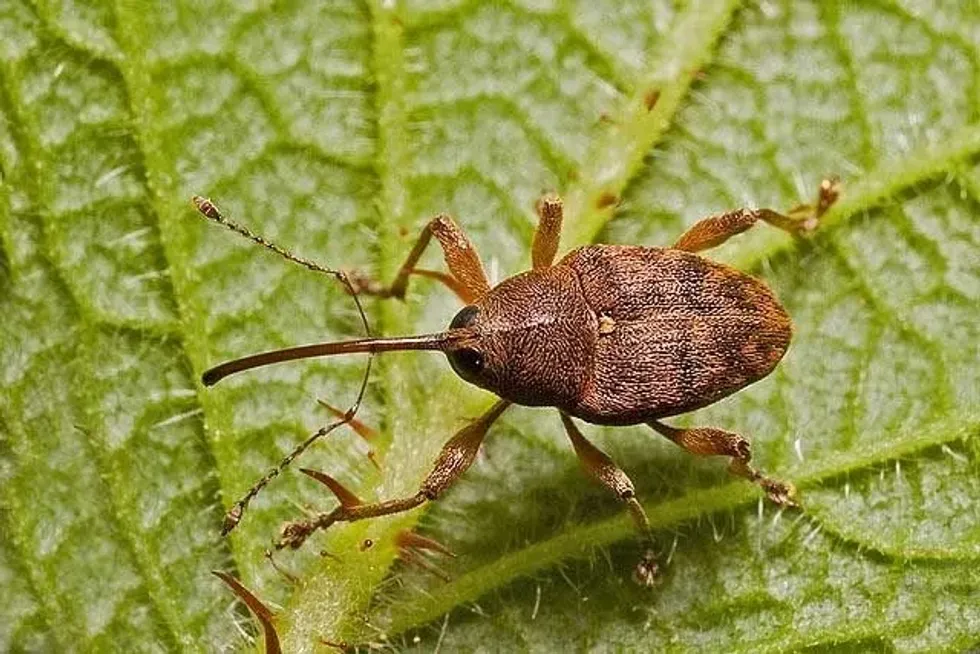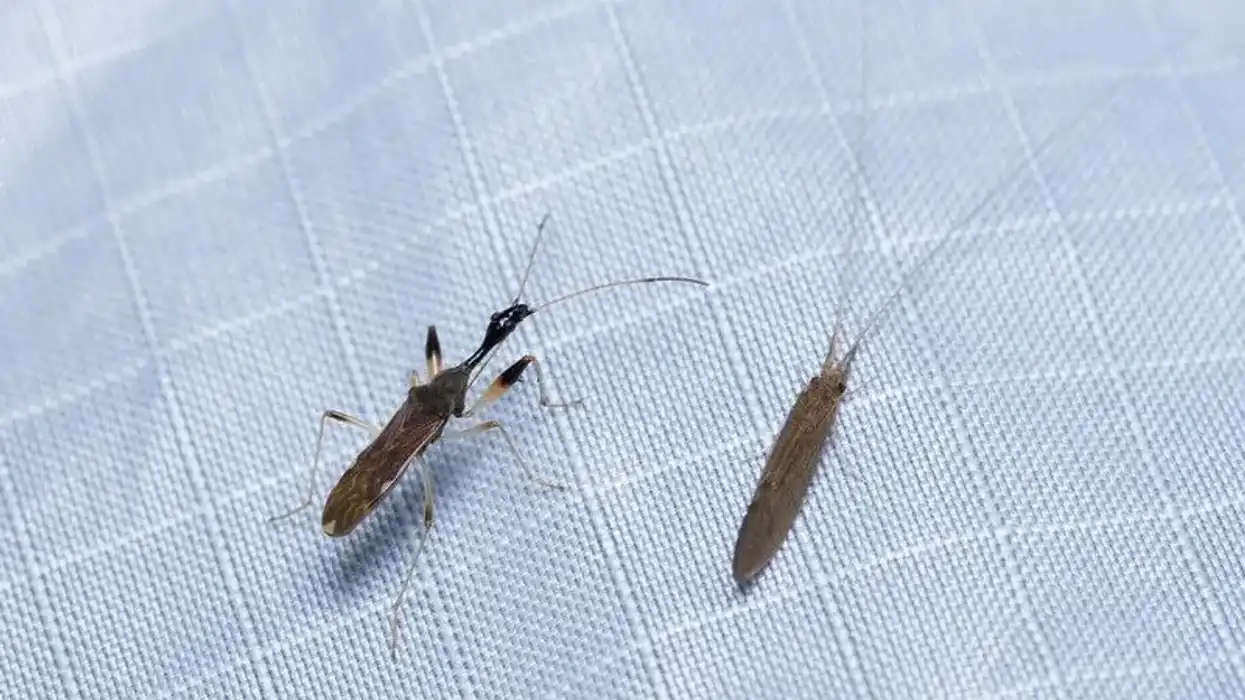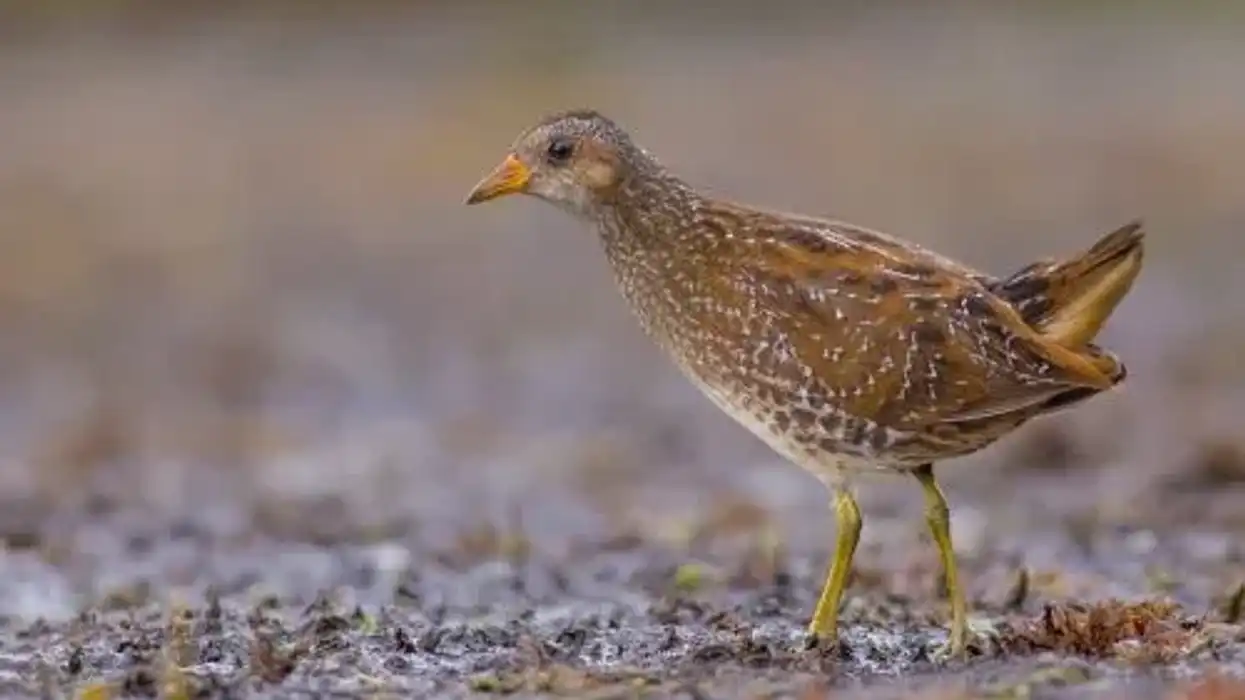The acorn weevil (or nut weevil) is a member of the family Curculioninae and genus Curculio, mostly found in parts of southern Europe and North America. They are a brown-colored species with different patterns on their body and a unique slender and long snout.
These snouts are called rostrums and they help in the identification of these beetles.
At the end of their snout, a chewing mouth is present. Rostrums (or the snout) in females are longer than those of males, which helps in identifying males and females of the same species.
A female uses the end of her snout to drill a hole into acorns or a hickory nut during the summer season while they are still in the tree.
Females lay eggs into the seeds of the young, green acorns of the oak tree which grow and harden through the summer season. The egg hatches into a creamy white grub-like weevil larva that feeds on the inner part of the seeds until it becomes brown and hardened and finally falls off in the early fall.
The acorn weevil larva digs a perfectly round hole in the acorns or hickory nuts when they fall to the ground and comes out through this hole, burrowing into the soil to avoid any threats.
It remains there throughout the winter. After a year the larvae pupate and emerges as an adult but they remain under the soil for another five to six months.
After these five to six months, they finally emerge as adult acorn weevils to repeat the cycle of existence.
Read on to know more about the acorn weevil, and if you like this article, then check out our facts bout the ambush bug and the stink bug too.
Acorn Weevil Interesting Facts
What type of animal is an acorn weevil?
The acorn weevil is a type of beetle.
What class of animal does an acorn weevil belong to?
The acorn weevil, or nut weevil, belongs to the class of Insecta.
How many acorn weevils are there in the world?
The exact population of these insects is not known, but they are found in immense numbers.
Where does an acorn weevil live?
Acorn weevils live in North America and parts of Europe.
What is an acorn weevil's habitat?
Acorn weevils mostly live inside nuts in oak trees until they develop into larvae. When the nuts fall to the ground they break through the nut by digging a hole in it and hide in the soil throughout the winter before they become an adult acorn weevil.
Who do acorn weevils live with?
Acorn weevils spend their lives alone inside an acorn nut.
How long does an acorn weevil live?
Acorn weevil larvae live for about two to three months inside acorns. Then, after burrowing itself into the soil, it remains there for a year.
After that, the larvae pupates and emerges as an adult but remains underground within earthen cells for another four to five months. They finally come out during the spring. So, the lifespan of acorn weevils is between one to four years in total.
How do they reproduce?
During summer, females search for suitable acorns in an oak tree on which to lay their eggs. Then, female adult acorn weevils drill a hole into their chosen developing acorn at the boundary between the wall and the skin of the acorn.
After that, by repeatedly inserting her snout she softens the walls of the acorn to build multiple chambered wounds where she lay one or more eggs in one of the chambers.
The egg hatches into a light-toned grub which is legless and cylindrical with a brown head.
This grub feeds on the inner part of the acorn. In the early autumn, when the acorns are brown and hard they fall off the trees to the ground.
This is a signal for acorn weevil larvae to dig a circular hole in the acorn for escaping. Then, the larvae bury themselves into the soil to a depth of 2 in (5.08 cm) approximately, where the insect remains hidden from threats during winter.
After almost two years the larvae pupate and develop into adult weevil bugs to repeat the acorn weevil life cycle.
What is their conservation status?
The conservation status of acorn weevils is Not Listed by the International Union for Conservation of Nature (IUCN) as they are found in abundance. Since they reside in oak trees, deforestation or immense cutting down of trees can be a threat to this species.
Acorn Weevil Fun Facts
What do acorn weevils look like?
The acorn weevil is a brown-colored beetle with different body patterns. It has a thin, slender, and long snout.
How cute are they?
Acorn weevils can be considered cute beetles as they have huge black eyes and a long snout that resembles an elephant's trunk.
How do they communicate?
Beetles communicate through biochemical means. Males locate female partners by scent and, as this species grows, they often make vibrations to communicate. As acorn weevils are beetles and beetles communicate this way, we can assume that acorn weevils also communicate in the same manner.
How big is an acorn weevil?
Acorn weevils are 0.4 in (1.02 cm) in length. They are smaller than honey bees which are 0.6 in (1.5 cm) approximately in length.
How fast can acorn weevils move?
The exact speed of their movement is not known, but we do know that they move very slowly with all six legs. Although they have wings, they cannot fly large distances so their flight seems more like a hop.
How much does an acorn weevil weigh?
An acorn weevil (or nut weevil) is so light that its weight is almost negligible.
What are the male and female names of the species?
There are no specific names of the males and females of the species.
What would you call a baby acorn weevil?
A baby acorn weevil is called larvae.
What do they eat?
Initially, an acorn weevil larva feeds on damaged tissues which are prepared by adults inside acorns and hickory nuts. After that, they feed on reserves stored within the cotyledons. Once they are an adult they come out of hibernation after two years and they feed on oak and other flowers throughout the summer.
Are they harmful?
Acorn weevils are not a harmful species to humans as they cannot damage furniture or carpets and they are not harmful to the pets in the house either. Also, an acorn weevil bite is not dangerous to humans.
Would they make a good pet?
Whilst it might seem like acorn weevil larvae can be a good pet since they are not harmful in any way to humans and can be kept inside the house as they do not harm furniture, carpet, people, or pets, the truth is that keeping an animal with such a short lifespan and such specific needs is too difficult.
Did you know...
The chewing of the acorn or the nutshell by an acorn weevil can take between two hours to three days. The timeframe depends on the thickness of the shell of the acorn.
An adult weevil female's snout can be almost twice the length of her body!
These weevils cannot be killed by pesticides. You have to collect the nut and freeze it to kill the grub inside.
What do acorn weevils turn into?
An acorn weevil larva turns into an adult acorn weevil.
Acorn Weevils And People
Strolling weevil larvae is not harmful in any way to humans. They only need to be swept away or picked up and discarded.
Here at Kidadl, we have carefully created lots of interesting family-friendly animal facts for everyone to discover! Learn more about some other arthropods including the yellow jacket wasp or the soldier beetle.
You can even occupy yourself at home by drawing one on our Acorn Weevil coloring pages.










